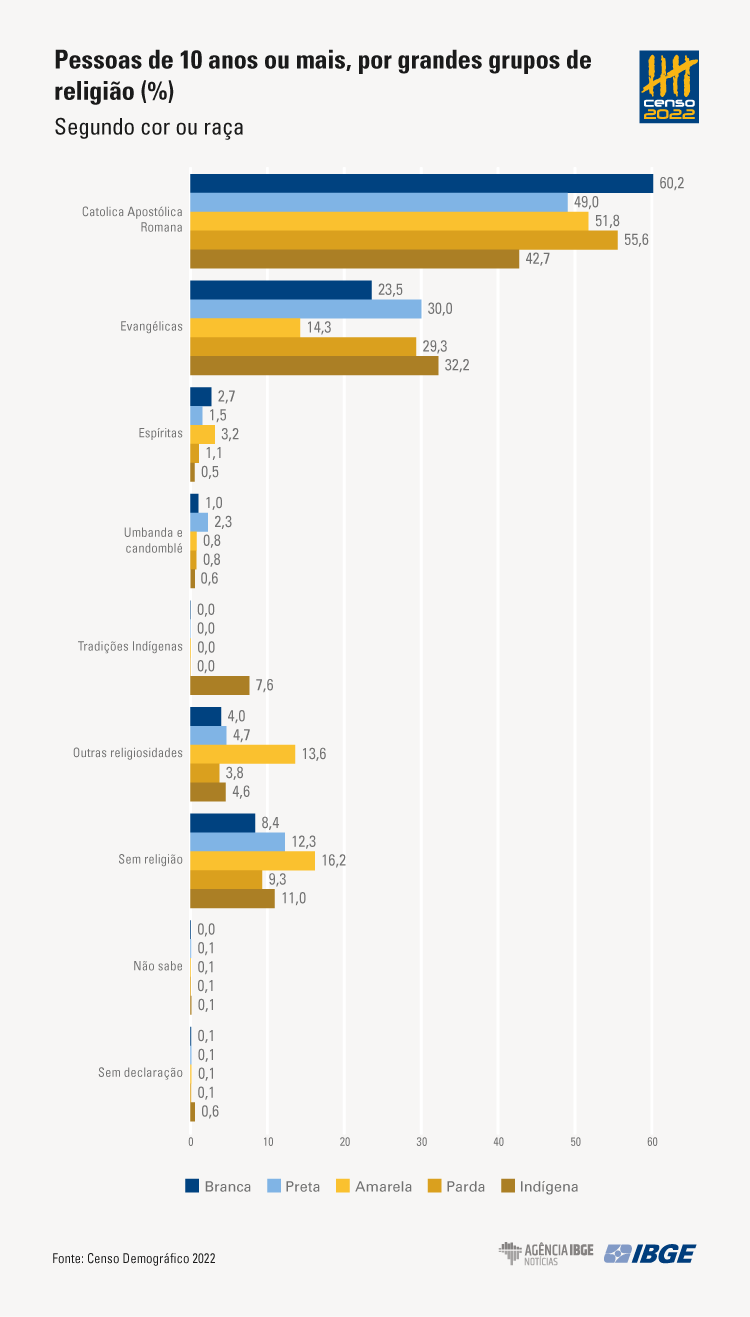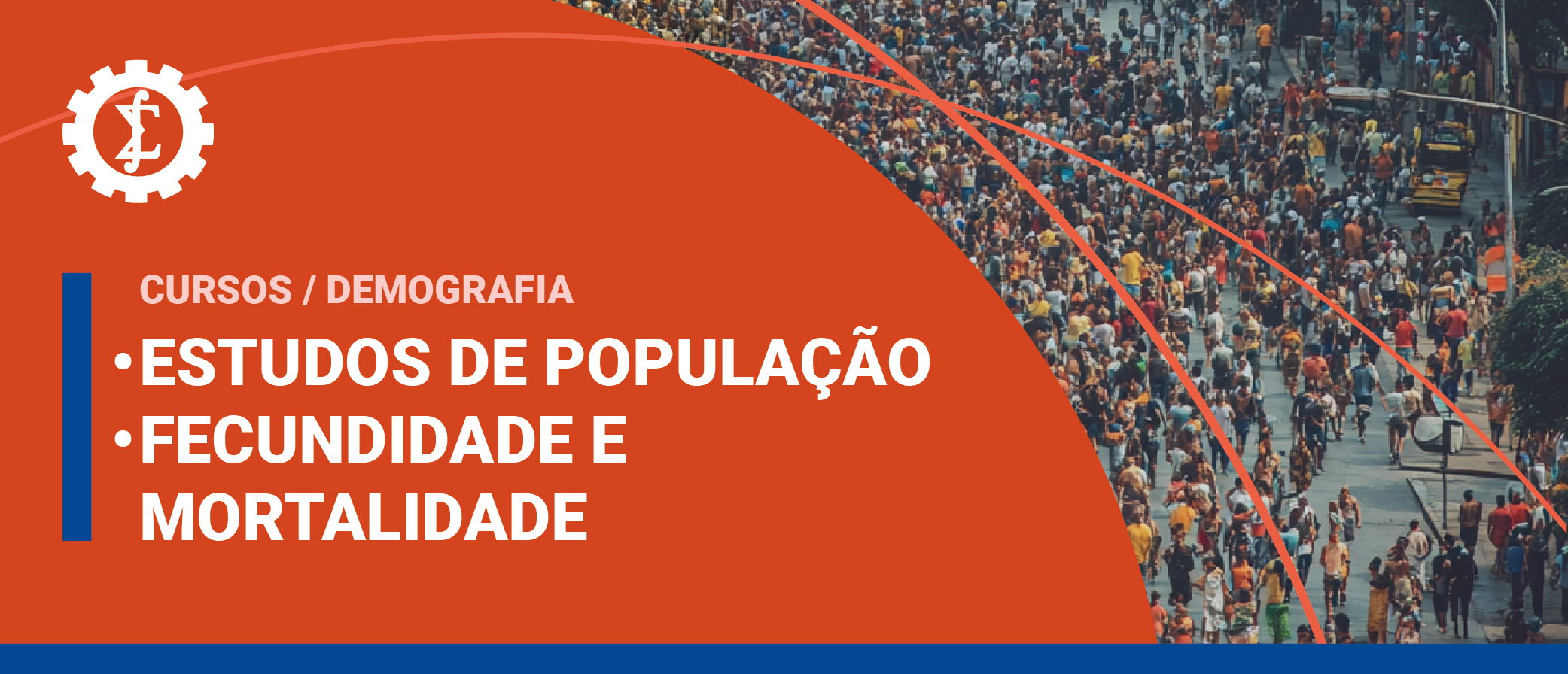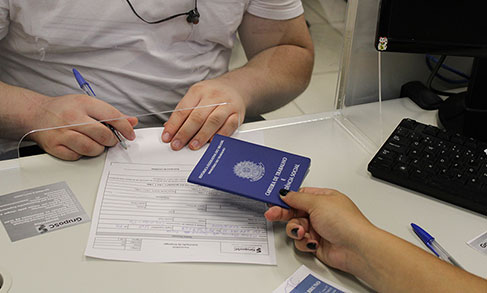2022 Census
2022 Census: Catholics remain in decline; protestants and persons with no religion increase in the country
June 06, 2025 10h00 AM | Last Updated: June 08, 2025 08h30 PM
Highlights
- From 2010 to 2022, according to data from the population Census, there was a drop in the percentage of Roman Catholics (56.7%) and an increase in that of protestants (26.9%) and of persons with no religion (9.3%). In 2010, Catholics were 65.1% of the population aged 10 and over, protestants were 21.6%, whereas persons with no religion corresponded to 7.9% of the informants.
- Among Catholics, there was a decrease of 8.4 percentage points (p.p.) from 2010. The proportion of protestants and of persons with no religion, in turn, increased 5.2 p.p. and 1,4 p.p., respectively.
- Spiritualism (1.8%) dropped 0.3 p.p. against 2010 (2.2%). Umbanda and candomblé, on the other hand, went from 0.3% in 2010 to 1.0% in 2022, an increase of 0.7 p.p.
- In 2022, Catholicism led in all the Major Regions in the country, being mostly concentrated in the Northeast (63.9%) and in the South (62.4%). A bigger proportion of Protentants was found in the North (36.8%) and in the Central West (31.4%).
- The biggest concentration of self-declared spiritists was found in the Southeast (2.7%), and candomble and umbanda practicioners were more often found in the South (1.6%) and in the Southeast (1.4%). The Southeast (10.5%) also has the biggest number of persons with no religion.
- Although Roman Catholics were the majority in all the age groups, the proportion of this group changed between 52.0%, in the group aged 10 to 14, to 72.0% among persons aged 80 and over.
- In 2022, Catholicism was predominant in all the categories of color or race, having reached 60.2% among white persons. Indigenous persons had the biggest proportion of protestants (32.2%). The biggest proportions of spiritualists (3.2%), and persons with other religions (13,6%) and with no religion (16.2%) were found among Asians.
- Indigenous religions (24.6%) and Roman Catholics (7.8%) were the religions groups with the highest illiteracy rates of personsaged 15 and over. The religious groups with the lowest illiteracy rates were spiritists (1.0%) and umbanda/candomble practicioners (2.4%).
- In 2022, spiritists were the ones with the lowest percentage of persons without schooling and with incomplete primary education (11.3%), and the highest percentage of persons with a higher education degree (48.0%).

The 2022 Population Census showed the consolidation of changes in the geogrpahic profile of Brazil. Roman Catholicism, which concentrated 65.1% (105.4 million) of the population aged 10 and over in 2010, amounted to 56.7% (100.2 million) in 2022, a drop of 8.4 percentage points (p.p.). On the other hand, there was an increase of 5.2 p.p. in the proportion of protestants, with a change from 21.6% in 2010 (35 million) to 26.9% in 2022 (47.4 million). Data are found in 2022 Population Census: Religions: Preliminary sample results, released today (06) by the IBGE. The release event started at 10 am, at Casa Brasil IBGE, located on the first floor of Palácio da Fazenda (RJ), streamed online on Digital IBGE.
The proportion of persons who declared having no religion increased by 1.3 p.p. between 2010 and 2022, having changed from 7.9% to 9.3%. The religions umbanda and candomblé (from 0.3 % in 2010 to 1.0%, in 2022) and other religions experiences (from 2.7% to 4.0%). There was a slight decreasse in spititualism (from 2.2% to 1.8%). Indigenous religions made up 0.1% of the reports.

“In 150 of religion censuses, a lot has changed in the country and in society as a whole,” says the analyst in charge of this yopic, Maria Goreth Santos, as she mentions the first Census. “In 1872, the enumerator used to classify each informant as ‘cathólico’ (Catholic) or ‘acathólico’ (non-Catholic), according to the spelling in effect at the time; there was no other option for one's religion." Also, all the slave population was counted as Catholic, following orders by their lord."
Today, information on religion in Brazil encompasses varied groups and subgroups. “The social changes have resulted in changes in the methodology throughout these decades. Codes, a classification structure and incorporation of religious declarations gradually became necessary to portray religious diversity in Brazil in the most trustworthy way possible,” Maria Goreth states.
Catholicism was the predominant religion in the country, having its biggest concentration in the Northeast (63.9%), followed by the South Region (62.4%), and the lowest proportion in the North Region (50.5%). Protestants ranges between 36.8%, in the North Region, and 22.5%, in the Northeast. The biggest proportion of self-delcared Spiritists were in the Southeast region, with 2.7%; as for Umbanda and Candomble practicioners, they were in the the South (1.6%) and Southeast (1.4%). Persons with no religion were mostly found in the Southeast Region, with 10.5 %, where there is also a high proportion of other religions (4.9%).
Among the 27 Federation Units, 13 have a proportion of Roman Catholics above the national average (56.7%), in the population aged 10 and over. The biggest proportion was registered in Piauí (77.4%), which is also the state with the lowest percentage of Protestants (15,6%). Roraima (37.9%), Rio de Janeiro (38.9) and Acre (38.9%) had rhe lowest proportions of Roman Catholics.
As for Protestants, the biggest proportion was registered in Acre (44,4%), and the smallest, in Piauí (15.6%). The biggest proportion of Spiritists was found in Rio de Janeiro (3,5%), whereas the biggest proportion of Umbanda and Candomblé practicioners was in Rio Grande do Sul (3,2%) – both positions had been registered in 2010. Roraima had the biggest proportion of persons with no religion (16.9%), of other religions (7.8%) and followers of Indigenous traditions (1.7%).
Pessoas sem religião são 9,3% dos brasileiros; maioria são homens
O Censo 2022 mostrou que a população que se declara sem religião continua aumentando, passando de 7,9% em 2010, para 9,3% em 2022, chegando a 16,4 milhões neste último Censo. A maioria são homens, que representam 56,2% ou 9,2 milhões de pessoas de 10 anos ou mais de idade.
A Região Sudeste, com 10,6% de sua população declarada como sem religião, foi a única com proporção acima da média do país, representando 7,9 milhões de pessoas. A menor proporção estava na Região Sul, 7,1%.
Entre as unidades da federação, as maiores proporções de pessoas sem religião estavam em Roraima e Rio de Janeiro (ambas com 16,9%); as menores estavam no Piauí (4,3%), Ceará (5,3%) e Minas Gerais (5,7%).
Evangélicos têm perfil mais jovem
Embora os católicos apostólicos romanos sejam a maioria em todos os grupos de idade, sua proporção variou entre 52,0%, no grupo de 10 a 14 anos de idade, a 72,0%, no grupo de 80 anos ou mais. Entre os evangélicos, a relação é inversa: a maior proporção (31,6%) se encontra no grupo mais jovem, de 10 a 14 anos, e o grupo de 80 anos ou mais representou a menor proporção, com 19,0%. O grupo sem religião atingiu sua proporção máxima na faixa entre 20 e 24 anos (14,3%) e a mínima entre a população com 80 anos ou mais de idade (4,1%).
Na desagregação da população por cor ou raça, o Censo 2022 revelou que, entre as pessoas brancas, 60,2% se identificavam como católicas apostólicas romanas, 23,5% se identificavam como evangélicas e 8,4%, como sem religião. Pessoas com cor ou raça indígena apresentaram a maior proporção de evangélicos (32,2%), enquanto pessoas amarelas apresentaram o menor (14,3%). As maiores proporções de espíritas (3,2%), outras religiosidades (13,6%) e sem religião (16,2%) se encontram entre pessoas de cor ou raça amarela.

Já na distribuição de cada grupo religioso por cor ou raça, verificou-se que o grupo espírita era composto em sua maioria por pessoas brancas (63,8%) e pardas (26,3%). Entre os evangélicos, a maioria era de cor ou raça parda (49,1%) e apenas 0,2% eram amarelas. Entre os umbandistas e candomblecistas, os maiores percentuais eram de brancos (42,7%) e pardos (26,3%). Entre a população de tradições indígenas, 74,5% eram de pessoas de cor ou raça indígena. Entre os sem religião, os maiores percentuais estavam entre pardos (45,1%) e brancos (39,2%).
Espíritas têm os melhores níveis de instrução
Entre as pessoas de 25 anos ou mais de idade, os espíritas apresentaram os menores percentuais de indivíduos sem instrução e com ensino fundamental incompleto (11,3%). É também o grupo com o maior percentual de nível superior completo (48,0%), uma diferença de 29,6 p.p. em relação ao total do país (18,4%). Já entre os católicos romanos, 38,0% são sem instrução e com ensino fundamental incompleto e apenas 18,0% têm nível superior completo. As pessoas de tradições indígenas têm os percentuais mais elevados para os sem instrução e com ensino fundamental incompleto (53,6%), uma diferença de 18,4 p.p. em relação ao total Brasil (35,6%) para o mesmo nível. Entre os evangélicos, a maior proporção é no nível médio e superior incompleto, com 35,2%, seguido por sem instrução e com ensino fundamental incompleto, com 34,9%.

Os espíritas também detinham as menores taxas de analfabetismo entre pessoas de 15 anos ou mais de idade, com 1,0%, seguidos pelos umbandistas/candomblecistas (2,5%) e outras religiosidades (3,0%). As taxas de analfabetismo mais altas se encontravam nos grupos de tradições indígenas (24,6%) e católicos apostólicos romanos (7,8%), ambas acima do índice nacional (7,0%). “No caso dos católicos, esse resultado relaciona-se ao já mencionado perfil etário mais envelhecido desse grupo. No caso das tradições indígenas, essa taxa de analfabetismo superior é esperada, considerando que 74,5% desse grupo é de pessoas de cor ou raça indígena, que, como um todo, já apresenta taxa de analfabetismo mais elevada”, explica o analista Bruno Mandelli Perez.
Censo 2022 traz novas informações sobre tradições indígenas
Nesta edição, o Censo aperfeiçoou sua forma de captação das respostas sobre religiosidade nas terras indígenas ou agrupamentos indígenas. Enquanto, para a população em geral, a pergunta sobre religião foi: “Qual é sua religião ou culto?”, nas Terras Indígenas e nos Setores Censitários de agrupamentos indígenas, a redação do quesito foi alterada para “Qual a sua crença, ritual indígena ou religião?”.
Essa adaptação foi elaborada para o melhor entendimento desse grupo populacional específico, como explica Marta Antunes, coordenadora do Censo de Povos e Comunidades Tradicionais do IBGE. “As diversas expressões da religiosidade indígena foram reunidas em complexos rituais organizados por etnia ou povo praticante, permitindo assim um registro de crenças e rituais indígenas mais aprofundado”. Aí se incluem rituais de festas, danças e pinturas corporais de momentos rituais específicos, assim como rituais mais vinculados a um povo, como o ritual Yrerua, entre os Uru Eu Wau Wau, exemplifica Marta.
Mais detalhes sobre essa composição serão abordados nas divulgações definitivas dos resultados da amostra para os povos indígenas, prevista para o segundo semestre de 2025.
Mais sobre a pesquisa
A divulgação Censo Demográfico 2022: Religiões: Resultados preliminares da amostra traz o perfil religioso da população residente no país, com base nas informações provenientes do Questionário da Amostra do Censo Demográfico 2022. Os resultados estão disponíveis para Brasil, Grandes Regiões, unidades da federação e municípios, desagregados, também, segundo a cor ou raça, o sexo e os grupos de idade dos moradores, alfabetização, nível de instrução e características dos moradores.
Os dados também podem ser visualizados no Panorama do Censo 2022 e no Sidra.



















